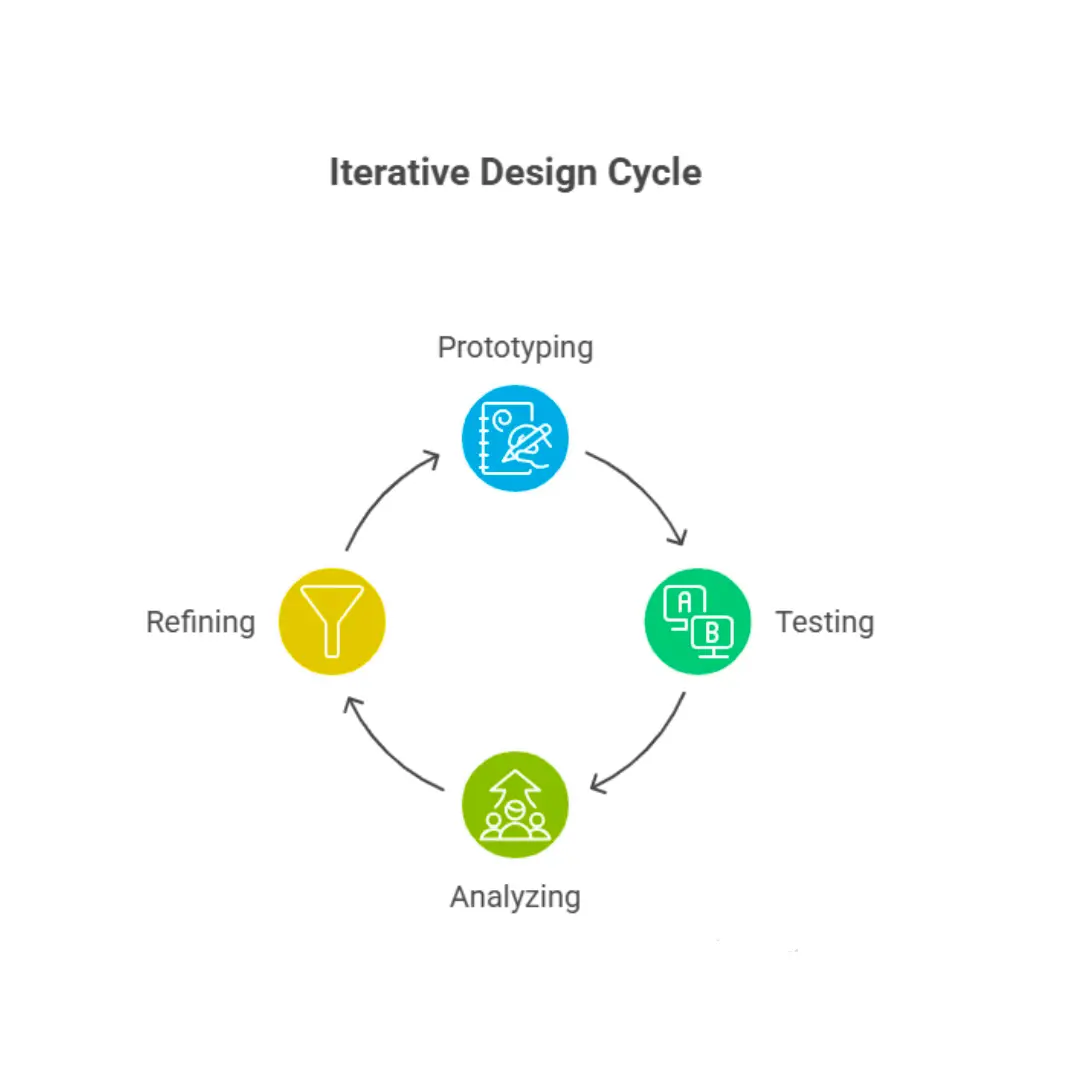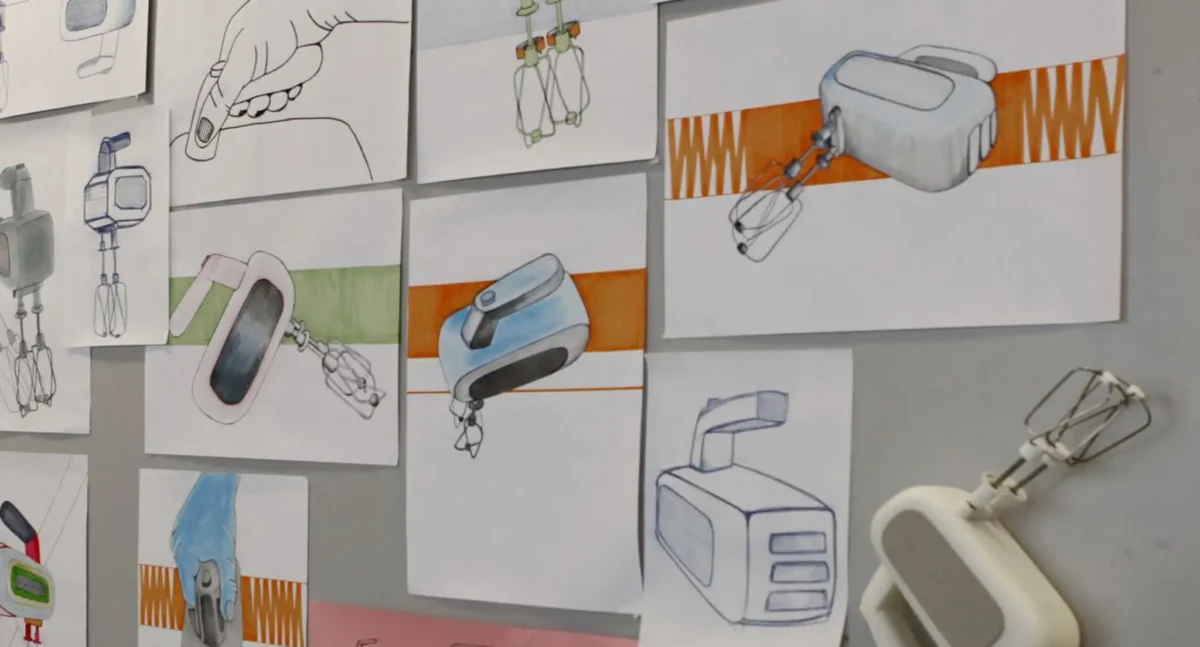Imagine a master sculptor. They don’t just look at a block of marble and create Michelangelo’s David with a single, flawless strike. They chip away. They step back. They study the light and the form. They make small adjustments, sometimes removing tiny slivers, sometimes larger chunks. The masterpiece emerges not from a single burst of genius, but from a disciplined, repetitive cycle of observation and refinement.
This is the heart of the iterative design process. In a world obsessed with speed and “first-mover advantage,” the idea of deliberately building, breaking, and rebuilding your product might seem counterintuitive. But at Shark Design, we’ve learned that this very process is what separates products that sink from those that swim.
This isn’t about corporate jargon or rigid, drawn-out timelines. It’s a practical, human-centered approach to creating products that people genuinely want and love to use. Let’s dive into how this process works and why it’s the most powerful tool in our product design and development arsenal.
What is the Iterative Design Process? (And What It’s Not)
At its core, iterative design is a cyclical method of prototyping, testing, analyzing, and refining a product or process. Instead of trying to launch a “perfect” final product straight out of the gate, you create a simple, functional version (a prototype), put it in front of real users, gather feedback, and use those insights to make it better. Then, you repeat the cycle.
Many people confuse this with the traditional Waterfall Model, a linear approach where each stage (e.g., research, design, development, testing) must be fully completed before the next one begins. It looks like this:
-
Plan Everything → Design Everything → Build Everything → Test Everything → Launch.
The problem with the waterfall model is its rigidity. If testing uncovers a fundamental flaw in the user experience, it’s often too late and too expensive to go back. The entire project is built on assumptions made at the very beginning.
The iterative process, in contrast, is flexible and adaptive. It looks more like this:
-
Plan a Little → Design a Little → Build a Prototype → Test with Users → Learn & Refine → Repeat.
The goal isn’t to be right the first time; it’s to learn as quickly and cheaply as possible to become right over time. It’s the difference between betting your entire budget on a single, long-shot idea and making a series of small, informed investments that steadily de-risk your project.
The Four-Stage Cycle of Iteration

While every project is unique, our iterative cycles consistently follow four key stages. Think of this as our engine for innovation.
Stage 1: Prototype – Give Your Idea a Body
You can’t test an abstract idea. The first step in any iteration is to create a tangible representation of your concept. The key here is fidelity—how close the prototype is to the final product.
- Low-Fidelity Prototypes: These are quick, cheap, and disposable. Think sketches on a napkin, paper models, or simple digital wireframes. Their purpose is to map out basic layouts and user flows. At this stage, we’re answering questions like, “Does the basic navigation make sense?”
- High-Fidelity Prototypes: These look and feel much more like the final product. They might be interactive digital mockups or 3D-printed models that you can hold in your hand. We use these to test specific interactions, materials, and aesthetics. The question now is, “Does pushing this button feel satisfying?”
The goal of the prototyping stage isn’t perfection; it’s to create the simplest possible artifact that we can learn from.
Stage 2: Test – Throw It to the (Friendly) Sharks
Once we have a prototype, we take it out of the lab and into the real world. This is where we gather the raw, unfiltered data that fuels the entire process. Testing involves observing real, potential users as they interact with the prototype.
We watch. We take notes. We ask open-ended questions:
- “What are you trying to do right now?”
- “How does this feel in your hand?”
- “What did you expect to happen when you pressed that?”
- “What part of this is frustrating or confusing?”
The magic here is in observing what people do, not just what they say. Someone might tell you they love the concept, but then struggle for five minutes to perform a basic task. That struggle is worth more than a thousand positive surveys.
Stage 3: Analyze – Find the Golden Nuggets
After testing, our team gathers to sift through the feedback. This is a detective phase. We look for patterns:
- Where did multiple users get stuck on the same step?
- What feature did everyone ignore?
- Was there a moment of delight we can amplify?
We separate the signal from the noise. One person’s quirky suggestion might be an outlier, but if five people can’t find the power button, that’s a critical design flaw. The outcome of this stage is a prioritized list of insights and actionable changes. We identify what worked, what didn’t, and, most importantly, why.
Stage 4: Refine – Sharpen the Edges
Armed with our analysis, we go back to the drawing board—literally. This is where we implement the changes. We might:
- Simplify a complicated assembly process.
- Change the texture of a grip for better ergonomics.
- Reorganize a digital menu for clearer navigation.
- Swap out a material for something more durable or sustainable.
The refinement stage isn’t about adding a bunch of new features. It’s about honing and improving the core product based on evidence. Once the refinements are made, we have a new, improved version of the prototype. And then? We start the cycle all over again.
Why We Swear By Iteration: The Tangible Benefits for Your Product
Adopting an iterative process isn’t just a methodology for us; it’s a philosophy that yields undeniable results.
- It Drastically Reduces Risk: Finding a major flaw in a $500 prototype is a learning opportunity. Finding the same flaw after you’ve spent $50,000 on tooling is a catastrophe. Iteration catches problems early when they are cheap and easy to fix.
- It Creates User-Centric Products: You are not your user. By constantly involving your target audience, you ensure the final product solves their problems in a way they find intuitive and enjoyable. This builds loyalty and market fit.
- It Manages Costs and Timelines Effectively: While it may seem like more cycles would cost more, the opposite is true. By preventing costly late-stage changes and ensuring you’re building the right thing, iteration is a far more efficient use of your development budget.
- It Fosters a Culture of Innovation and Collaboration: When the team knows that the first draft isn’t the final draft, it creates psychological safety. Designers, engineers, and clients can collaborate more freely, proposing bold ideas without the fear of failure, because every “failure” is just a step toward a better solution.
A Shark Design Case Study
Let’s make this concrete. We recently worked with a startup on a smart home gardening appliance. The founder had a strong vision for a sleek, touch-screen interface.
- Iteration 1 (Low-Fi): We built a paper prototype with button labels. In testing, users especially older gardeners—were confused by the icons and struggled to navigate the menu hierarchy.
- Insight: The touch-screen, while aesthetically pleasing, was a barrier to the primary user base.
- Iteration 2 (Mid-Fi): We refined the digital interface, simplifying the language and adding a physical dial for the most common function (setting water levels). Testing showed improved usability, but users found the dial slippery and unresponsive.
- Insight: The tactile feedback of the dial was as important as its function.
- Iteration 3 (High-Fi): We created a 3D-printed model with a knurled, rubberized dial that provided a satisfying “click” with each turn. We also used a more matte screen to reduce glare. The response was overwhelmingly positive. Users called it “intuitive” and “a joy to use.”
The final product was successful not because of the founder’s initial vision, but because that vision was refined and improved through three iterative cycles, guided by real user feedback. We de-risked the project by discovering the touch-screen issue early and created a superior product by focusing on tactile ergonomics.
Embracing the Iterative Mindset:
How can you apply this thinking to your own product journey?
- Start Small and Simple: Your first prototype should be the bare minimum version of your idea. Don’t over-engineer it.
- Seek Honest, Brutal Feedback: Don’t just ask your friends and family. Find people in your target market and create an environment where they feel comfortable being critical.
- Separate Your Ego from the Idea: It’s not “your baby”; it’s a work in progress. Criticism of the prototype is not a criticism of you. It is valuable data.
- Focus on the Problem, Not the Solution: If users are struggling with a feature, don’t just explain how it should work. Ask why they are struggling and be willing to change the solution entirely.
- Celebrate “Failures”: Each time you find a flaw in a prototype, you’ve just saved yourself a huge headache down the line. That’s a win.
Ready to Refine Your Vision?
At Shark Design, we don’t see ourselves as just a product design and development company that executes a brief. We see ourselves as your partner in navigation. The journey from a spark of an idea to a successful product in the hands of users is rarely a straight line. It’s a series of loops, a process of continuous learning and improvement.
The iterative process is our map for that journey. It’s a disciplined, practical, and profoundly effective way to ensure that when your product finally hits the market, it’s not just something that works, but something that thrives.
If you have an idea that you’re ready to prototype, test, and refine into a market-ready success, contact us today. Let’s start building, learning, and creating something remarkable, together.

